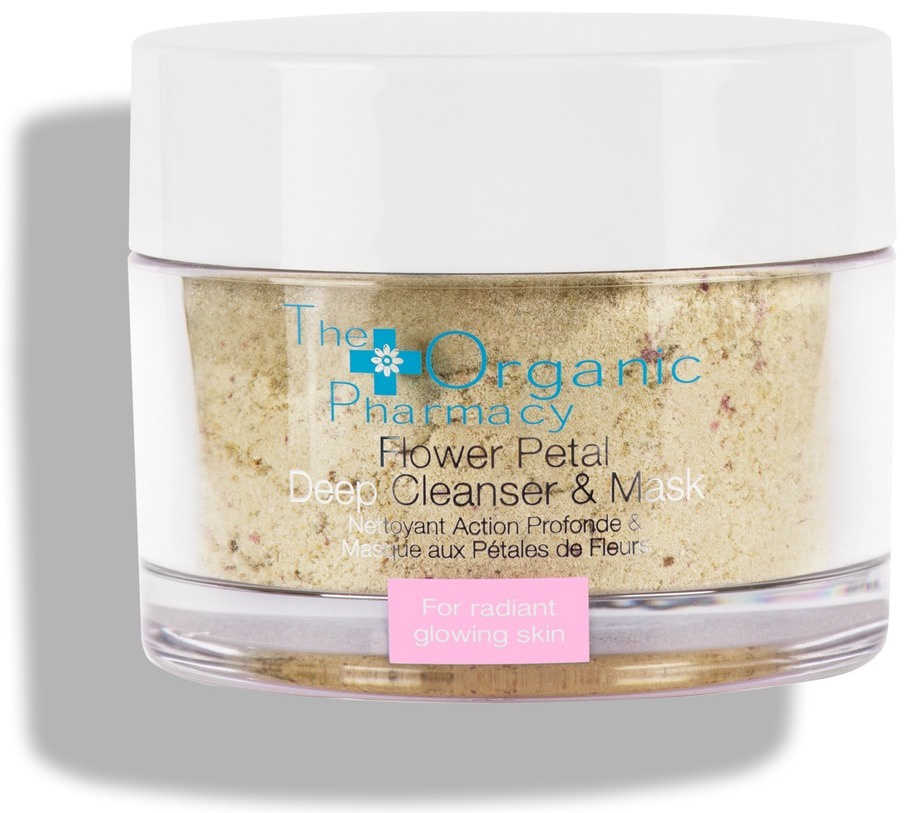
Flower Petal Deep Cleanser And Mask
Highlights
Skim through
| Ingredient name | what-it-does | irr., com. | ID-Rating |
|---|---|---|---|
| *Avena Sativa (Oat) Kernel | antioxidant, soothing, emollient, abrasive/scrub | goodie | |
| *Lac (Milk) Powder | |||
| Montmorillonite | viscosity controlling | goodie | |
| *Chamomilla Recutita (Matricaria) Flower | |||
| *Lavandula Angustifolia (Lavender) Flower | |||
| *Pelargonium Graveolens Flower Oil | perfuming | icky | |
| *Rosa Centifolia Flower | |||
| Citral | perfuming | icky | |
| Citronellol | perfuming | icky | |
| Geraniol | perfuming | icky | |
| Limonene | perfuming, solvent | icky | |
| Linalool | perfuming | icky |
The Organic Pharmacy Flower Petal Deep Cleanser And MaskIngredients explained
When you hear oatmeal, you probably think of breakfast, but the finely ground version of whole oat kernels, aka colloidal oatmeal, can do good things for your skin, especially if it's dry, itchy or prone to skin-rashes or eczema.
Oat is loaded with compounds good for the body, inside or outside, such as soothing agent beta-glucan (5%), lipids (3-11%) including barrier repairing omega-3 and 6 fatty acids or phenolic antioxidant and anti-inflammatory agents (avenanthramides).

A type of clay that was originally found next to the French village, Montmorillon. Nowadays, Montmorillonite is used almost like a synonym for the most common type of clay, bentonite. Technically bentonite is montmorillonite and additional crystalline structures, or to put it another way, montmorillonite is 100% clean bentonite.
As for montmorillonite in skincare products, it's used for its magic absorbent properties. It's excellent at instantly sucking up sebum and gunk from the skin and it might even be helpful in treating some rashes or skin irritations (contact dermatitis). But be careful, it can also be drying.


The fragrant essential oil coming from the flowers of Rose Geranium. Like most essential oils, it contains antioxidant and antimicrobial components, but the main ones are fragrant constituents (like citronellol and geraniol). Be careful with it, if your skin is sensitive.

It’s a common fragrance ingredient that smells like lemon and has a bittersweet taste. It can be found in many plant oils, e.g. lemon, orange, lime or lemongrass.
It’s one of the “EU 26 fragrances” that has to be labelled separately (and cannot be simply included in the term “fragrance/perfume” on the label) because of allergen potential. Best to avoid if your skin is sensitive.
Citronellol is a very common fragrance ingredient with a nice rose-like odor. In the UK, it’s actually the third most often listed perfume on the ingredient lists.
It can be naturally found in geranium oil (about 30%) or rose oil (about 25%).
Geraniol is a common fragrance ingredient. It smells like rose and can be found in rose oil or in small quantities in geranium, lemon and many other essential oils.
Just like other similar fragrance ingredients (like linalool and limonene) geraniol also oxidises on air exposure and becomes allergenic. Best to avoid if you have sensitive skin.
A super common and cheap fragrance ingredient. It's in many plants, e.g. rosemary, eucalyptus, lavender, lemongrass, peppermint and it's the main component (about 50-90%) of the peel oil of citrus fruits.
It does smell nice but the problem is that it oxidizes on air exposure and the resulting stuff is not good for the skin. Oxidized limonene can cause allergic contact dermatitis and counts as a frequent skin sensitizer.
Linalool is a super common fragrance ingredient. It’s kind of everywhere - both in plants and in cosmetic products. It’s part of 200 natural oils including lavender, ylang-ylang, bergamot, jasmine, geranium and it can be found in 90-95% of prestige perfumes on the market.
The problem with linalool is, that just like limonene it oxidises on air exposure and becomes allergenic. That’s why a product containing linalool that has been opened for several months is more likely to be allergenic than a fresh one.
You may also want to take a look at...
| what‑it‑does | antioxidant | soothing | emollient | abrasive/scrub |
| what‑it‑does | viscosity controlling |
| what‑it‑does | perfuming |
| what‑it‑does | perfuming |
| what‑it‑does | perfuming |
| what‑it‑does | perfuming |
| what‑it‑does | perfuming | solvent |
| what‑it‑does | perfuming |





